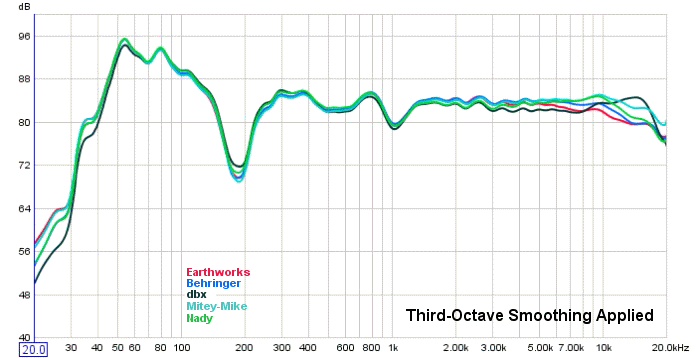hello all, i hope this is the correct section for this thread.
i have this dbx m2 mic, trying to make measurements for my speaker project with REW.
the only info i can find about it here: http://www.aes.org/sections/pnw/pnwrecaps/2012/jj_jan/acoustic_meas_sys_101.pptx
the m2 response as shown in the pics attached has abig bump at the high frequences
is there an appropriate calibration file for it? anyone using this mic?
thanks for your time
i have this dbx m2 mic, trying to make measurements for my speaker project with REW.
the only info i can find about it here: http://www.aes.org/sections/pnw/pnwrecaps/2012/jj_jan/acoustic_meas_sys_101.pptx
the m2 response as shown in the pics attached has abig bump at the high frequences
is there an appropriate calibration file for it? anyone using this mic?
thanks for your time
Attachments
I do have a RTA-M (which should be the same mic sold separately).
Attached is a spec sheet by AV Leader, the actual maker.
The tolerance field is relatively wide, so for precise measurements
one would need a individual calibration file.
I found two generic files on the net:
http://www.hometheatershack.com/for...243-dbx-rta-m-calibration-curve-dbx-rta-m.cal
http://www.audiorail.com/dbx_RTA-M.dat
Attached is a spec sheet by AV Leader, the actual maker.
The tolerance field is relatively wide, so for precise measurements
one would need a individual calibration file.
I found two generic files on the net:
http://www.hometheatershack.com/for...243-dbx-rta-m-calibration-curve-dbx-rta-m.cal
http://www.audiorail.com/dbx_RTA-M.dat
Attachments
hmmm, if i load the files (they are the same file actually) with c-weighting it looks like it will do (edit: or not? shouldn' it be the other way around in the high fr?), i'll test it at first chance (see attachement)
thank you very much sir😀
thank you very much sir😀
Attachments
Last edited:
If I load the .cal file (renamed to .mic) into Arta ( ARTA Software ),
it looks like the attached picture (slight bass rolloff and pronounced top end).
Arta compensates in the opposite direction (lowers the HF output shown in
the frequency response graph).
it looks like the attached picture (slight bass rolloff and pronounced top end).
Arta compensates in the opposite direction (lowers the HF output shown in
the frequency response graph).
Attachments
I have just tried a (very rough and coarse) compensation based on
the frequency graph in your first post on a measurement I made lately,
and the result looks a lot more plausible.
Will look deeper into this ...
the frequency graph in your first post on a measurement I made lately,
and the result looks a lot more plausible.
Will look deeper into this ...
^^^ this one looks much more reasonable, i think i can use it
maybe i'll get a behringer too to see how they compare (can't afford a decent mic atm)
if i come up with anything new i'll post it😎
maybe i'll get a behringer too to see how they compare (can't afford a decent mic atm)
if i come up with anything new i'll post it😎
Checked my microphone and looks similar to one from #1. Correction from data-sheet is definitely not enough.
Resurrecting this to add little more info on the dbx RTA M2 short plastic mic. This one was an accessory from a dbx DriveRack PX but it remained unused.
Strongly peaking in HF as others also wrote above. Anyway, here's my Cal for it too in case someone will be looking and it fits close to his M2's tolerances.
Strongly peaking in HF as others also wrote above. Anyway, here's my Cal for it too in case someone will be looking and it fits close to his M2's tolerances.
Attachments
Guys,
i have the same mic stored for years
now i downloaded REW and bought a mackie interface just for it
do i need to get an UMIK1 or i can get away with the DBX mic , if so
what is the correct file
for the RTA M2 mic
post#7 or post#11
Best,
i have the same mic stored for years
now i downloaded REW and bought a mackie interface just for it
do i need to get an UMIK1 or i can get away with the DBX mic , if so
what is the correct file
for the RTA M2 mic
post#7 or post#11
Best,
Both files are valid. They just come from different individual RTA M2 mics. If you got some speaker with reliable third party tested & published frequency response you can try both files and compare which one brings closer 3kHz-20kHz results when using your own M2 mic.
The zero degrees file is for aiming the mic straight at a speaker. The ninety degrees file is for aiming it up to see surrounding speakers equally like in a home theater or in a car.
This mic can also be used in dual channel time synchronous (loopback) mode since it has analog XLR output. For correct phase in progressive off axis takes. A USB mic is practical but you can't be sure of digital time delay in each take. That can change the curves relative phase and give wrong predictions in multi angle simulation.
The zero degrees file is for aiming the mic straight at a speaker. The ninety degrees file is for aiming it up to see surrounding speakers equally like in a home theater or in a car.
This mic can also be used in dual channel time synchronous (loopback) mode since it has analog XLR output. For correct phase in progressive off axis takes. A USB mic is practical but you can't be sure of digital time delay in each take. That can change the curves relative phase and give wrong predictions in multi angle simulation.
- Home
- Design & Build
- Equipment & Tools
- DBX RTA M2 condenser mic








